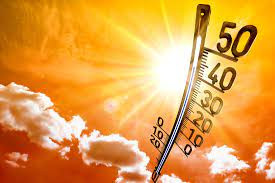
People are panting indoors and out due to intense heat wave and heat. Public life is a mess. As soon as you leave the house, it is like the wind of the desert. Road pitch is melting due to excessive heat. Occasional monsoons and rains bring some relief at this time of year; But this time it is not there. Like the last two years, the month of April has become terrible.
Once Rajshahi Division and part of Khulna Division used to get very hot during summer. And because of the rising temperature, the suffering of heat was more. In the last 10 years, 80 percent of the country has experienced intermittent heat waves from March to July. And creating the most suffering and suffering is the extremely hot temperature and humidity that prevails throughout most of this month, which is known as ‘Wet Bulb Globe Temperature’. Such warm weather has started to turn into deadly disasters like floods and cyclones.
At this time of April, the average temperature of Bangladesh is 33 degrees Celsius. But it stays between 35 and 37 degrees Celsius for a week. Yesterday, the highest temperature in the country was 42.6 degrees Celsius in Jessore. And the temperature of Dhaka has crossed 40 degree Celsius. The average temperature across the country was above 36 degrees Celsius.
In such a situation, the government has announced a seven-day holiday for all schools and colleges in the country. The classes of affiliated colleges of the National University have also been closed. In the meantime, the requirement of wearing black gowns for advocates of Supreme Court Appellate and High Court Divisions has been relaxed. Emergency health risks are increasing due to extremely hot weather. Hospitalizations for heat stroke may also increase. The health department is preparing to deal with the situation.
According to the forecast of the Meteorological Department, during the rest of this month, the heatwave will sweep through the country intermittently during the first week of May. And there may be danger of extreme heat and humidity till July-August.
Shamsuddin Shahid, a temperature researcher and professor at University Technology Malaysia, said that people’s suffering and danger cannot be understood only by the intensity of temperature in summer in Bangladesh. A heat wave, i.e. temperature not exceeding 36 degrees Celsius, can create dangerous weather anywhere. If the temperature is between 30 and 35 degrees Celsius and the humidity is above 40 percent and there is little air flow, there can be danger of overheating. The danger of extreme heat is being created in Bangladesh throughout the month of April.
How dangerous April is getting
In February this year, the Department of Meteorology published a research report titled “Impact of Climate Change in Bangladesh”. It said April temperatures have risen rapidly to dangerous levels in the past 60 years. More than half of the country is experiencing a heat wave for most of this month. In other years, this time is accompanied by several gales, gales, and rains for several days. It reduces the temperature to some extent. This time there is no rain and wind.
For four days, the maximum temperature in 70 percent of the country crossed 35 degrees Celsius. And yesterday, the maximum temperature in at least 12 districts of the country was more than 40 degrees Celsius.
According to the Meteorological Department, the humidity or water vapor content of the air in April is 75 percent; But for most of this month it was between 85 and 90 percent. Yesterday, air humidity in Dhaka was 89 percent.
In most countries of the world, including East Asia, severe weather is declared when the temperature rises above 40 degrees Celsius. And when the temperature is above 32 degrees Celsius and humidity is above 30, it is declared as hazardous weather.
According to a 2022 study published by the Bangladesh Meteorological Department, the heat wave is the highest in the month of April. According to the report, Rajshahi, Khulna, Dhaka and Barisal divisions have the highest temperature.
Scientists from Dhaka University, Jahangirnagar University, Bangladesh Oceanographic and Maritime Institute jointly conducted the research under the leadership of Abdul Mannan, a former meteorologist of the Meteorological Department. According to research, the human body is not able to adapt to that high heat. In addition to increasing the risk of various diseases, the risk of death is also increasing. The high temperatures are creating shortages of drinking water and electricity in the city. Apart from this reducing crop production and creating drought conditions. The extreme heat is also contributing to human temper tantrums and social unrest.
Bajlur Rashid, meteorologist of Meteorological Department, said that the weather in April is becoming very dangerous due to excess temperature and other reasons. As a result, the concerned institutions have to take a quick plan for the protection of public health, agriculture and livestock of this period.
what to do
To avoid the dangers of overheating, experts have suggested taking necessary measures for additional irrigation in agriculture. He also said to provide additional water and shade for cattle.
ASM Maqsud Kamal, Vice-Chancellor and Professor of Disaster Science and Climate Resilience Department of Dhaka University said, ‘Usually excess heat was seen as a general meteorological problem here. But if we look at the calamities that hit Bangladesh throughout the year, which are damaging people’s lives and property, such as floods, cyclones and the April heat wave, it becomes detrimental to our lives. After declaring lightning as a disaster, people’s awareness about it has increased, deaths have decreased. Heatwaves should also be seen as important disasters for us.’

 Reporter Name
Reporter Name 

















